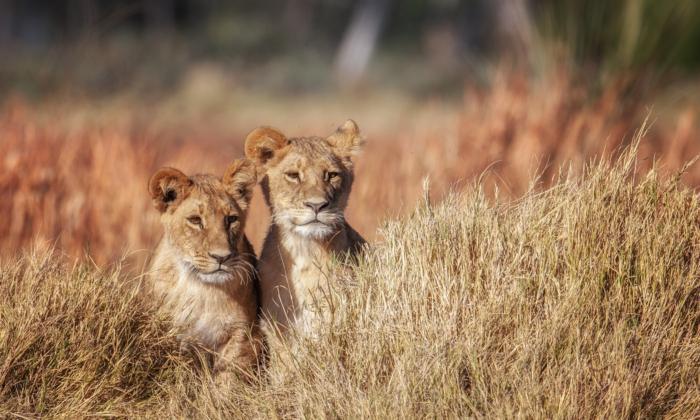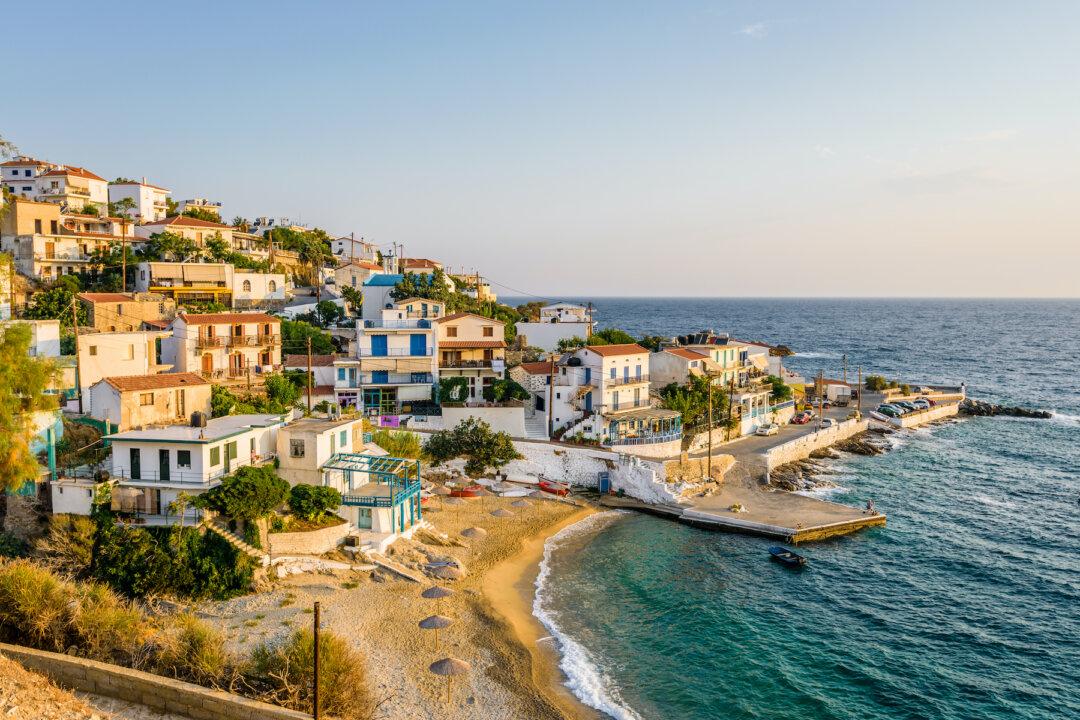“Lioness on your left, about 10 o’clock, 70 meters from us.” Attorny Vasco, projects manager for Wilderness, Botswana, was sitting in the back of our Land Cruiser, seemingly with his eyes closed. I had binoculars over glasses over eyes that were wide open, but even with six eyes, I saw nothing but gently swaying grass.
But then, something flicked. I focused my binoculars and zoomed in on the swishing tail of a lion, the first I had ever seen in the wild. Like liquid gold, it moved languidly toward us, weaving through grass that matched its fur perfectly. Soon, it was by our vehicle, its bourbon-colored eyes sizing us up. It held my gaze for a few seconds, and in those eyes, I caught a glimpse of my own cats and wondered afresh at the miracle of nature. Having had enough admiration, it padded away, its unhurried movements belying the 50-plus miles per hour it’s capable of when hunting.
We’d see it again later, in that mode. We stopped to watch a cheetah devouring its kill. Noticing the animal’s body tighten with tension, we followed its eyeline and, there in the grass, saw the lioness stalking it. Cheetahs are the weakest of the big cats, their only defense against apex predators being their speed, and this one knew that it had only a minute at most before it'd have to surrender its meal and run for its life.
Measuring the diminishing distance between them, it tore at the flesh voraciously, barely swallowing. Grabbing one last chunk, it sprang, just as the lioness made its move in an audacious snatch-and-grab, seizing the carcass for its cubs.

Exploring Africa’s Prairies
I saw all of this and so much more within a few hours of leaving Wilderness Chitabe, in Botswana, in southern Africa, the first of three camps run by leading conservation operator Wilderness that I would visit during my six-day stay.Chitabe covers 22,000 hectares of wilderness in the heart of the UNESCO-listed Okavango Delta—a remarkable alluvial fan of lagoons, channels, and islands that, at 6,000 square miles, is the largest inland wetland area in the world and a life source for hundreds of species. Safaris should never be about ticking animals off a list, but in a matter of hours, I had seen many of the creatures that I had dreamt of seeing in the wild since the day I first learned of their existence, including three cats—lions, cheetahs, and leopards—giraffes, and, perhaps the biggest thrill of all, painted dogs.


I’d arrived at Chitabe after a long journey from the UK the night before that first drive and had gone straight to my tent, a luxurious thatch-capped villa that was decorated in the colors of the Kalahari and Okavango and which floated on an expansive, timber deck.
And that’s when my safari began, with an orchestra of wildlife roaring, calling, trumpeting, chasing, scampering, catching, fleeing, flying, creating life, and ending it—all close to where I lay. Too excited to sleep, I waited for the moment when I would meet some of my noisy neighbors.

Not long after I finally dozed off, there was a knock at my door, which was accompanied by a hot drink and a request that I be ready in 10 minutes to be escorted to reception. It wasn’t that the walk was long—Chitabe is an exclusive camp comprising just eight lodges—but it was one that might have brought me closer to the wildlife than it was advisable to get.
“We share our camps with the animals,” Vasco said. “Our tents are on their land, and there’s nothing that stands between us and them. We are their guests, and we have to respect that. Elephants and baboons might be right outside the villas, so we like to accompany guests to and from their rooms at night.”

Call of the Wild
Game drives start early and cold and, despite my multiple layers, I dove into the poncho and blankets that were provided, tucking a hot water bottle deep into them for good measure. Our senses already sharpened by anticipation and the earthy aroma of wild sage, we set off before the red, orange, pink, and gold of the rising sun began to spread across the sky.As dawn gave way to day, indistinct shapes took form. Emerging from the twilight were jackals standing on gargantuan termite mounds and scanning the terrain like snipers, as well as zebras and impalas, red lechwe, and a lone hyena. Ostrich and roadrunners raced comically past us. And then came the giraffes—their impossibly long necks and legs a miracle of form and function—gracefully picking their way through the grasslands. As Julian Fennessy, a world expert on the species and director/co-founder of the Giraffe Conservation Foundation, said in an interview some years ago, “You have to love something so big and weird.”
You do have to love them, and yet it seems we’re failing to do so, because the species is endangered. Mr. Fennessy says that the giraffe is going through a silent extinction; in the 18th century, there were a million giraffes in Africa. Now, there are only 117,000, according to the Giraffe Conservation Foundation.


We drove on. Above me flew lilac-breasted rollers, which were quite the most exquisite birds I had ever seen. Their plumage seemed to suggest they’d tried on every color and, unable to decide which suited them best, had kept the lot. For all I saw, Tank, our superb guide, saw and showed me more. Intuition, experience, passion, and an affinity with nature seemed to have given him superhuman hearing and vision.
He cut the engine and pointed. There, draped over a baobab branch, was a leopard snoozing after a kill. Yet, Tank explained, it’d spring if it saw an opportunity for another meal. That opportunity appeared soon enough, when an impala danced close by, impervious to the life-ending machine above it. For many safari-goers, seeing a kill is a highlight, but that wasn’t the case for me. I held my breath as my pulse soared with suspense as the animal grazed closer to the leopard. A few more steps and it would be directly beneath it. I was happy to see it turn and bolt away.
We continued. Tank leaned out of the jeep and pointed at the ground. My heart leapt. I was looking at the tracks of one of the most endangered and fascinating creatures on Earth: the painted or wild dog. I’d been in love with them ever since I’d first seen them on television decades before, enchanted by their coats of many colors—burnished gold, fall red, black, white, and brown—their enormous round ears and their complex social relationships. He proceeded slowly, following their four-toed imprints (unlike dogs, which have five), until we found them.
Fiercely loyal to their pack and led by an alpha female, African wild dogs communicate by touch, actions, and vocalizations, and make important decisions by voting—yes, you read that right. They vote—by sneezing
It was an incredibly moving and deeply sad experience, for this species is also endangered. A century ago, 500,000 of the animals roamed across 39 countries in Africa. Now, estimates put the total population across the continent at 6,600. The need for the packs to build up their own numbers has resulted in puppy raids, in which one group abducts the young of another.

Close Enough to Touch
The next day, we left Chitabe to travel north to our second camp in Okavango, Vumbura Plains. Our flight took us across the water channels that feed the Delta’s flood plains, mopane forested islands, and marshlands. Seen from above, they appeared like arteries, and, indeed, that’s what they are: a vital, life-sustaining force for one of the most ecologically important habitats in the world.When we arrived, my room was unavailable, not because the bed was still to be made, but because an elephant was snacking on the tree by my door. Half an hour later, it allowed me into my lodge. It was a beautifully designed indoor-outdoor space, with rich wooden floors, décor inspired by the Delta’s waterlilies, and an unobstructed view of the savanna. An elephant stopped just a few feet from where I sat—so close that I could count every wrinkle in its skin, and every one of the 40,000 or so muscles in its trunk. Birds with iridescent feathers, beaks, or feet swooped and soared past. Every moment was magical.
After a superb meal that was as rich in flavor and color as Africa itself, with plant-based options that satiated even the die-hard carnivores, we drove into the night to explore Vumbura’s wilderness.
The two notorious lion brothers who'd taken over the territory from another pride—killing the cubs to claim the females—were already out hunting. They walked silently past, their magnificent manes rising in the breeze. What a thrill it was to be so utterly ignored by them.
Thus far, we had experienced Botswana’s wildlife from the air and on land, so the next day, Vasco took us out in mokoros (canoes) to enjoy the beauty of the Delta from the water. Dappled reed frogs no bigger than a thumbnail clung to blades of grass, malachite kingfishers flashed past in a flurry of sapphire blue and orange, and dragonflies darted all around. Not wishing to be outdone, the day waterlilies put on their own show, unfurling delicate petals while their night-time relatives curled up until dusk.
On the way back to the camp, we stopped for sundowners while watching a herd of elephants walk trunk to tail along the water’s edge. It was a joy to watch how they used their trunks to siphon water into their mouths or to shower their backs, but Vasco interrupted my cooing over a calf, trotting to catch up with its mother, to remind me that this wasn’t a Disney film. Any second, he said, a crocodile could tear off that baby’s trunk. However miserable its existence would be after that, nature would be left to take its course since there can be no question of intervention.
The day after, we flew to our final camp, DumaTau, a private concession overlooking the Osprey Lagoon, in the Linyanti Wildlife Reserve, near the border with Namibia. There was such an abundance of wildlife right in front of my lodge, built from reclaimed timber, that I would have had plenty of sightings had I stayed put for the day. But instead, I took a river cruise, which brought me within feet of a hippo raising its huge head out of the water, and flinging its jaws open into a yawn that seemed to reveal eternity.
We also followed the call of a troop of baboons and watched their behavior—as familiar to us as our own, except for, perhaps, their habits of eating the lice that they groomed out of each other’s fur and picking through dung for tasty morsels. Otherwise, the playing, nurturing, and camaraderie were instantly recognizable and hardly surprising, considering that we share more than 90 percent of the same DNA.
“Did you know they’re so terrified of snakes, they faint at the sight of one?” our guide Nicos asked. I didn’t. But I did know several people who'd do the same!

Choosing a Safari
Safaris are an expensive holiday, so work out your budget first. Then decide what to do with it. Research is key. Ask yourself: What do I want to see, and when can I travel? Remember that nature is seasonal!I had long since dreamt of seeing African painted dogs, lions, cheetahs and leopards, elephants, and giraffes in the wild, so I narrowed my options to countries where there were established populations of these species. After much deliberation, I chose Botswana, not only because of its hugely diverse landscape—which includes the Okavango Delta and makes it one of the best safari destinations in the world—but also because of its commitment to wildlife preservation. This is backed by some of the most stringent anti-poaching laws in Africa and a directive to employ a domestic workforce.
As a first-time safari-goer, I knew that I needed expert guidance, and I made this a priority when deciding on an operator. As a travel journalist, I had a few invitations to choose from, but I went with Wilderness because I had heard great things about the level of training that it offered its guides. I wasn’t disappointed. The three guides whom I had were all exceptional.
In addition, Wilderness has worked in Botswana for more than 40 years, and its camps are mainly on private concessions, which means that its guests are the only ones who have access to vast swaths of land. Additionally, the different locations provide opportunities to experience hugely diverse ecosystems and wildlife, and to view animals from land, water, and the air, as well as at night. Finally, I was impressed by its eco-credentials, which include zero single-use plastics, solar-powered camps, eco-friendly detergents and toiletries, reverse-osmosis water filtration, and an excellent record of supporting and educating local communities.






